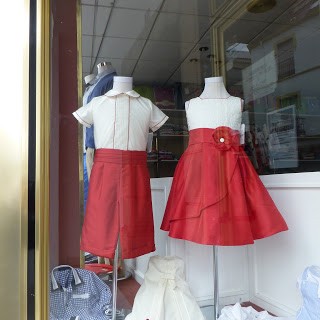We're far from Spain, but can't seem to find the time to add new photos, get the blog going in that direction. We're now in Wales, and have been enjoyed the beautiful countryside south of London, a week in a tiny surfing town in Cornwall (SW Atlantic), Somerset (Essex NP), and are now in Wales in the Brecon Beacons NP, about to set off for hiking in the waterfalls portion of this park -- the waterfalls should be spectacular after all the rain the country's had. But there were a couple of posts begun in Spain that want to be aired, so here are a few things about Spain that were unusual or telling, or beautiful.
The two photos below are of children's clothing for sale in Seville; on the left, for first communion, on the right for younger kids' 2-6 or so, for dressy occasions. Seville was a very formal city, especially during our time there, the April Faire.


 |
| Store front reading Sex, Fun & Love. Banana, ladies' lips, so subtle. |

Interesting zippers on the dress to the left. I thought it was a nursing dress; Steve thought otherwise.
 |
| Street artist in Seville. He annointed donators with Duff. |
 |
| Very narrow streets in Granada. |
 |
| Spaniards call the ham we're used to here (pink, relatively bland and salty) Jamon York because the type originated in York, UK; my dad's name was John York, and I found it constantly amusing. |
 |
| They called this sculptural structure in central Seville the Sunbrella. Made of steel, assembled waffle style just a year ago, it stands out amid the ancient architecture. There was a walkway above, very cool. |
 |
| Bullfighters travel with their own horses; this was parked outside the bull ring while Diego Ventara was "fighting". We attended a bull fight while in Seville - don't know whether to write about it. Gruesome, oddly compassionate, interesting, |
 |
| Seville's orange trees were ready for picking. The city has more than 200k orange trees. Over 400 years ago bitter orange trees were planted for the use of orange pith in gun powder production (or so we were told). The trees continue to thrive, but most of the oranges are considered inedible, and only a small portion of the crop is exported for use in marmalade production. We weren't there for the rotting stage, but the concurrent orange blossoms were delightfully fragrant. |
 |
| This horse was grazing right in the middle of Seville, in a not-so-little fenced off pasture. |
 |
| More evidence of the communal nature of the white storks, southern Andalusia. Four above, and below. |
 |
| This Catholic vestment was unusually Asian in theme. From Ronda. |
 |
| Book exchange in a park in Seville, tucked in a dry spot, folks were encouraged to take a book and after reading to leave it for another. |
 |
| Cork trees harvested and left to grow more for future harvesting. It takes awhile to grow a new layer, and the black bark underneath is a stark and beautiful contrast. |
 |
| I went for a walk in the countryside early one morning, and these two watchdogs kept a close eye on me as I passed their farm. That morning's sounds were memorable: first silence, then birdsong, then the roosters, then the alarms sent up by dogs passing word of my walk down the road, then the clanging of cow bells as they went in for milking. |
 |
| A friendly looking fire hydrant in Granada. |
 |
| Ah, the wisteria! Blooming extravagantly in many Andalusian cities. So fragrant, so beautiful, and tasty (the flowers are edible; the peas are slightly poisonous). Usually in purple, occasionally white. |



 Interesting zippers on the dress to the left. I thought it was a nursing dress; Steve thought otherwise.
Interesting zippers on the dress to the left. I thought it was a nursing dress; Steve thought otherwise.















1 comment:
The dress with the zippers is really odd. I'm with Steve; I don't think it's for nursing mothers. --Ann
Post a Comment